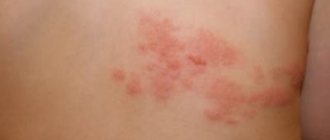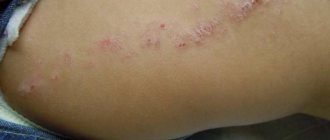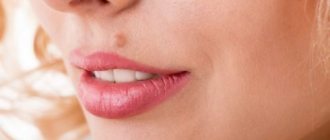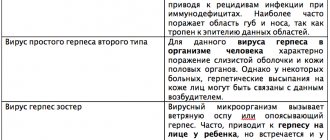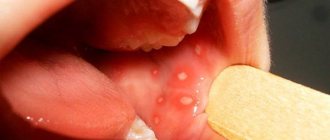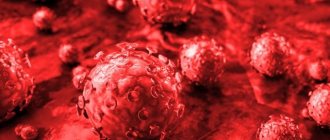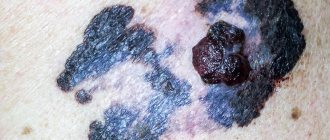Causes of skin rash
The appearance of pimples on a baby's body can be caused by improperly started complementary feeding or non-compliance with the diet of the nursing mother. Contacts with external irritants also provoke the formation of a rash; allergies are caused by detergents, synthetic fabrics, various creams or ointments.
When a baby begins to cut his first teeth, salivation increases. The skin on the chin and neck is constantly wet, irritated, and a small pink rash appears on its surface. In the case of a secondary bacterial infection, the development of streptoderma, pyoderma, and the formation of multiple pustules is possible, accompanied by a deterioration in the general well-being of the baby.
Rash on a child’s neck: what to do, what are the causes
The skin of babies is an extremely sensitive, delicate organ, it reacts to almost everything. The cause of rashes on the baby's skin can be:
- allergies to food, in particular to what the mother consumes;
- drug rashes;
- contact dermatitis;
- diaper dermatitis;
- atopic dermatitis;
- prickly heat;
- urticaria:
- neonatal acne;
- infectious rashes.
The neck is one of the most sensitive parts of the human body. The skin in this area is highly sensitive to various types of irritating factors, and it is in this area that a rash most often occurs.
Children are much more susceptible to all sorts of irritants than adults, so rashes on the neck, shoulders, or behind the ears may indicate a reaction to insufficient care or a serious illness.
A rash that appears on the baby’s neck will require mandatory medical consultation.
Prickly heat
In infants, the immune defense and thermoregulation system of the body have not yet been fully formed. With prolonged overheating, hyperthermia, non-compliance with hygiene rules, and wearing clothes made of synthetic materials, the sweat glands begin to actively produce secretions to cool the body.
Symptoms of prickly heat in a newborn differ depending on the type of disease:
- The crystalline form is characterized by the formation of whitish blisters no more than 2 mm in diameter. After 2–3 days, they spontaneously open, leaving transparent crusts or flaky spots in their place. Papules may merge into one large blister. The rashes are localized on the face and neck, in the groin, axillary folds, and less often on the child’s back.
- Miliaria rubra looks like a small red rash; inside the pimples there is a cloudy liquid, the surrounding dermis is red and inflamed. The pathology causes severe discomfort and itching of the skin. Kids become capricious and irritable. Discomfort increases with rising air temperatures in hot weather.
- The papular type of miliaria manifests itself in the form of bodily pimples on the chin, neck, chest, popliteal and elbow folds. The disease occurs in the hot season or when the child is wrapped tightly. Later, scaly spots remain at the site of the rash.
When scratching the rash or causing a bacterial infection, the blisters begin to fester and turn into erosions or painful ulcers.
Rashes in a child after vaccination against rubella-measles-mumps
The list of mandatory vaccinations for children includes the so-called trivalent vaccine. It can prevent three diseases at once - rubella, measles and mumps. Usually this vaccination is given to a child at 13 months of age.
Sometimes you may experience a rash in the form of pimples or spots, as well as some other side effects. But, according to doctors, their manifestation is not dangerous, but is a reaction confirming the child’s normal immunity.
The rash may be subtle and may sometimes appear even a few days after vaccination.
In isolated cases, large pimples (the size of a grain of lentil) may appear within a few hours all over the body or in places, mainly on the back and buttocks.
Body temperature can rise to 38°C.
Treatment is symptomatic.
Hives
This is an allergic pathology, accompanied by the formation of multiple itchy pimples on the child’s body. Skin signs occur in response to an external or internal stimulus. In infants, urticaria is characterized by an acute course, a deterioration in general well-being, chills, fever, and upset bowel movements may appear. In severe cases, bronchospasm, Quincke's edema, and anaphylactic shock develop.
Treatment of allergic dermatitis on the neck, limbs and torso
To eliminate skin manifestations of an allergic nature, complex treatment is always used.
Use of systemic antihistamines. For children under 12 years of age, it is better to use drops or suspensions:
- Zodak is allowed to be used from two weeks of age;
- Fenistil is allowed from the first month of life;
- Zyrtec can be used from six months;
- Suprastinex is approved for use by children from two years of age.
For older children, you can use tablet forms of drugs, namely:
- Diazolin;
- Claritin;
- Gismanal.
The use of local antiallergic, anti-inflammatory, restorative agents:
- Fenistil;
- Dexpanthenol;
- Elidel;
- La-cree;
- Soventol;
- Desitin;
- Gistal;
- Wundehill;
- A-dermis;
- Topicrem.
Use of hormonal topical medications. If the rashes cannot be treated with the above remedies, then doctors resort to:
- Akriderm;
- Sinaflan;
- Advanta;
- Elokom.
To cleanse the body of harmful substances I use:
- Polysorb;
- Smecta;
- Atoxyl;
- Enterosgel;
- Sorbex;
- Polyphepan.
If the pathology is accompanied by bacterial or fungal infections, antibiotics or antimycotics are prescribed. The required medications are prescribed exclusively by the doctor, taking into account the patient’s age and the course of the disease.
To restore the correct microflora, the following are prescribed:
- Bifidum Bagh;
- Trilact;
- Ecoflor;
- Probilance.
Treatment of allergic dermatitis is carried out by a doctor, individually selecting a treatment complex, course, and dosage. Properly selected treatment will relieve the baby of unpleasant symptoms in the first days of therapy.
Intertrigo
With constant moisturizing of the skin and mechanical stress, the child may experience diaper rash. The pathology is localized in the natural folds of the neck, groin, armpits, buttocks, arms and legs. During maceration, favorable conditions are created for the proliferation of pathogenic bacteria and fungi.
The cause of the development of the disease may be poor hygiene, excessive salivation during teething, improper treatment of the dermis, the use of irritating creams or other cosmetics. Diaper rash most often occurs in premature infants, overweight children, those suffering from food allergies, systemic, genetic diseases, and those on artificial nutrition.
At first, the skin turns red, later a small rash appears in the child, and after opening the papules, cracks and inflamed erosions form. The third degree of pathology is characterized by the formation of weeping ulcers, microbial eczema, and skin itching. Infants become irritable, are often capricious, sleep poorly, and lose their appetite.
Red pimples in a child on the neck, armpits and below
Perhaps it's scarlet fever . It is an infectious “childhood disease” that is transmitted by airborne droplets through contact with contaminated objects or patients. A child's rash usually appears on the second day after infection. Initially, acne is observed in the neck and upper body (usually in the armpits), and then the rash “goes” down. Lastly it spreads to the limbs and face. As a rule, it does not affect the skin around the nose and mouth - there it appears whiter than the rest of the affected part of the face. Pimples are usually small and red (bloody), with a brighter appearance on the top. Under pressure they change their color to pale gold. At the last stage of the disease, specific peeling of the skin on the palms and soles of the feet is observed. With scarlet fever, the temperature also rises, and the child looks lethargic, which is noticeable even before the appearance of pimples.
You should definitely consult a doctor immediately. Quarantine is usually necessary because the disease is contagious. Parents should inform the kindergarten or school if the child attends one of them. Treatment is aimed at preventing complications of the disease and is carried out symptomatically. It is recommended that the child drink more fluids and stay in bed.
Streptoderma
If a child has a rash on the face, neck, lower back, genitals or chin that looks like blisters filled with cloudy liquid, the cause may be streptoderma. The disease is contagious and is transmitted through close contact with a sick person. The causative agent of the pathology is streptococcal infection.
Conflicts initially form in places of microcracks and scratches. With frequent rhinitis, the skin in the area of the nasolabial triangle is subject to maceration and frequent friction, which creates favorable conditions for the development of bacteremia. Frequently ill children and premature babies are at risk. Poor hygiene care and external exposure to high or low temperatures can be a provoking factor.
Initially, single conflicts form on the skin, the surrounding skin is inflamed and hyperemic. The vesicle contains serous fluid, which gradually turns into purulent masses. After a few days, the papules open and form yellow crusts. The appearance of a rash on the face, neck or stomach of a child is accompanied by severe itching. Children scratch the sores, infected liquid gets on their hands, and the disease spreads to other parts of the body that the baby touches.
During the first few weeks of life, a baby may experience a variety of skin problems, most of which will resolve soon. Neck rash is one of them that is not so easy to notice because it is hidden in the skin.
Causes of rashes on a child's neck
Neck rashes in babies appear as small bumps on the skin. They may appear red, especially in fair-skinned children.
The causes of the rash are different:
- Leftover milk: Babies tend to spit some milk out of the corners of their mouth when feeding from either a bottle or breast. This stream collects in the skin folds of the neck. The liquid creates a moist environment, which is a breeding ground for microbial infections.
- Drooling: Drooling is a common developmental feature in babies between three and six months of age. Saliva often travels from the mouth to the folds of skin in the neck area. If not wiped away, fluid buildup can cause skin rashes due to friction.
- Heat rash: This rash usually occurs during the summer season, affecting the neck and other areas of the body. The rash appears as tiny red, itchy bumps on the skin. The main reason is constant sweating in babies. Additionally, the extreme dry heat of summer can irritate baby's delicate skin. Heat rash can also develop in winter if the child is dressed too warmly.
- Friction: Baby's neck is short and tends to wrinkle. In chubby cats, they are usually thicker and can rub against each other. Constant contact with each other and moisture due to sweating can lead to a rash on the neck. The rash will continue until the baby learns to lift his head without support.
Symptoms of a rash on a child's neck
The most common symptoms are itching accompanied by pain. This can cause irritation to the point where the child loses his appetite.
Home Remedies to Reduce Rash on Baby's Neck
As mentioned earlier, most cases of skin rashes in children tend to go away on their own within a few days. They do not require any treatment. However, you can relieve the discomfort of those annoying itchy bumps:
- Instead of heavy and bulky fabrics, choose lightweight and breathable material such as cotton. On a hot summer day, you can dress your baby in a diaper and a cotton top.
- Never wash your baby's clothes with strong bleaches or detergents. Harsh chemicals can irritate your skin and lead to breakouts.
- Apply skin creams and lotions to the rash: Be sure to consult your pediatrician before using any product, especially if your baby is less than six months old.
- Use cornstarch: According to a study published in the American Journal of Pediatric Dermatology, this product does not increase the growth of yeast on the skin and provides protection against rashes aggravated by friction. You can try sprinkling cornstarch on your baby's neck before taking him outside or after a bath.
- Use oatmeal: A study published in the American Journal of Clinical, Cosmetic and Research Dermatology reports that colloidal oatmeal is a safe and effective ingredient in personal care products. It may also be useful for treating itchy skin. Add oats to your baby's bath.
- Make a cold compress: soak a clean towel in ice water. Place it on the affected area for 5-10 minutes to soothe inflamed skin. After this, pat your neck dry.
- Use boiled or distilled water to bathe your baby. It does not contain harmful germs that could otherwise cause harm.
- Massage with coconut oil twice a day. Thanks to its softening and antimicrobial properties, the oil is an excellent preventive care product for baby’s delicate skin.
When should you see a doctor?
The rash on your baby's neck may go away on its own. However, if in addition to it, there are other health problems, then you can determine this by the following signs:
- heat;
- areas that appear moist, oozing, and red;
- pus- or fluid-filled blisters;
- significant scratches;
- incessant crying.
Additionally, if you notice small red dots that do not go away when pressed, you should contact your doctor immediately. These spots may appear due to bleeding under the skin and are called petechiae. As a rule, they signal the presence of a serious infection.
References:
- Zekayi Kutlubay et al.; Newborn Skin: Common Skin Problems; National Center for Biotechnology Information (2017)
- Rash under the chin and in other skin folds in babies; CYA, South Africa
- Drooling and Your Baby; Healthy Children; American Academy Of Pediatrics (2016)
- Heat Rash; Healthy Children; American Academy Of Pediatrics (2013)
- Canadian Pediatric Society; Skin care for your baby; National Center for Biotechnology Information (2007)
- Leyden JJ.; Corn starch, Candida albicans, and diaper rash.; National Center for Biotechnology Information (1984)
- Maryline Cricket et al.; Safety and efficacy of personal care products containing colloidal oatmeal; National Center for Biotechnology Information (2012)
- Verallo-Rowell VM et al.; Novel antibacterial and emollient effects of coconut and virgin olive oils in adult atopic dermatitis.; National Center for Biotechnology Information (2008)
- Rash – child under 2 years; Medical Encyclopedia; Medline Plus; National Institute of Health; US National Library of Medicine
On Vikids you can:
Find a doctor and make an appointment
Find a clinic and make an appointment
Go to Forum
Read similar articles
Treatment of the rash
If any rashes appear or the baby’s general well-being is disturbed, it is necessary to consult a pediatrician.
For prickly heat and diaper rash, you should pay special attention to hygiene procedures, treat the skin with talcum powder, a special cream, monitor the room temperature and dress the baby in accordance with weather conditions.
In advanced stages, medicinal, drying or antibacterial ointments are prescribed.
Allergies
Allergies are the second most common cause of rashes in babies. The baby’s body is unusually susceptible to the effects of unfavorable factors, therefore allergic reactions can be caused by irritants that the body of adults can cope with without much difficulty. The rash can be caused by:
- various foods consumed by the child himself or his mother during breastfeeding;
- medicines;
- incorrectly chosen body care products (soap, shampoo, cream);
- pet hair;
- dust in the room;
- plant pollen.
Allergic rashes are accompanied by an increase in body temperature, sleep disturbances, loss of appetite, and sometimes even breathing problems. If an allergy occurs, you should not practice self-treatment; you should immediately consult a doctor. You need to remember: an allergy that is not stopped in time can cause anaphylactic shock and cause death. If rashes quickly spread throughout the baby’s body, and other symptoms are added to them, you need to call an ambulance.
The baby’s immune system is just developing, and therefore a rash in children may well be a sign of allergic reactions. There are so many allergens for babies that identifying them is not easy. Try to remove the factors that most often provoke allergic reactions.
Expert advice
Provide your baby with good care, and be very responsible when choosing cosmetics and detergents for your baby. Products from the adult range should not be used to care for a child's skin. A thoughtful attitude towards your baby’s health will help protect him from prickly heat and allergies.
If a rash does appear, consult a doctor as soon as possible. Do not self-medicate, as medications and folk remedies that are completely harmless for an adult can cause considerable harm to a child’s health.
Infectious diseases
A rash caused by infectious lesions can take different forms - from minor reddish dots to large ulcers. The main diseases that cause rashes in babies:
- measles;
- scarlet fever;
- chicken pox;
- staphylococcus;
- pseudotuberculosis.
They are extremely dangerous, therefore, if you notice the initial symptoms, you need to promptly consult a doctor.
Often infections are accompanied by significant fever, chills, sleep problems, and other unpleasant symptoms. An infectious rash can be painful and itchy. Parents should ensure that the child does not scratch the rash, as this can lead to the spread of infections to other parts of the body. Treatment of infection includes antibiotic therapy, requiring complex solutions. Only a doctor can choose the appropriate therapy.
